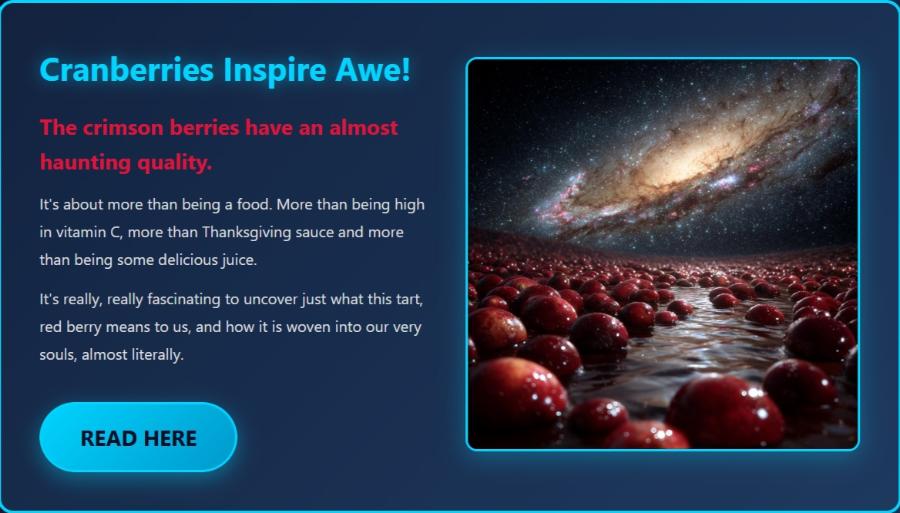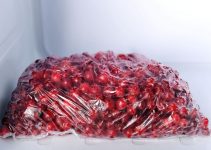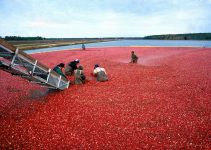
Cranberries are mostly Water
…
Fact 1- Cranberries are almost 90% water
On average, fresh cranberries are about 88% water by weight. This means that in every 100 grams of fresh cranberries, 88 grams are water. The remaining 12 grams include sugars, acids, fiber, and small amounts of proteins and fats. The high water content gives cranberries their firm texture and helps them float (along with air pockets) when bogs are flooded during harvest.
Water makes up the main part of a cranberry’s structure. The fruit grows on low vines in sandy, acidic soil. During the growing season, the plant takes in water through its roots. This water moves through the stem and into the developing berries. Inside each berry, water fills the cells and forms the juice. The skin of the cranberry holds this water in place. The skin is thin but strong, which keeps the berry intact even when it is full of liquid.

Rain as part of getting water into cranberries
The water in cranberries, like all crops, comes from rain and irrigation. Cranberry bogs are built in areas with sandy soil and a high water table. Growers use ditches and reservoirs to control water levels. In spring and summer, water keeps the soil moist so the vines can grow. Too little water causes the berries to stay small. Too much water can drown the roots. Growers aim to keep the soil damp but not flooded during most of the year.
In fall, growers flood the bogs for harvest. They open gates or turn on pumps to let water cover the vines. The berries float because of the aforementioned water content and because they contain air pockets along with water. Each berry has four small air chambers inside. These chambers trap air as the berry grows. When the bog is flooded, the water lifts the berries off the vines. Machines then collect the floating fruit. The high water content and air pockets make this wet harvest method possible.
After harvest, cranberries are cleaned and sorted. Most go to processing plants. About 95% of cranberries are turned into juice, sauce, or dried fruit. The water inside the berries becomes part of these products. For example, cranberry juice is mostly water from the berries with added sugar. One cup of cranberry juice contains about 200 milliliters of liquid, nearly all of it from the original fruit water.
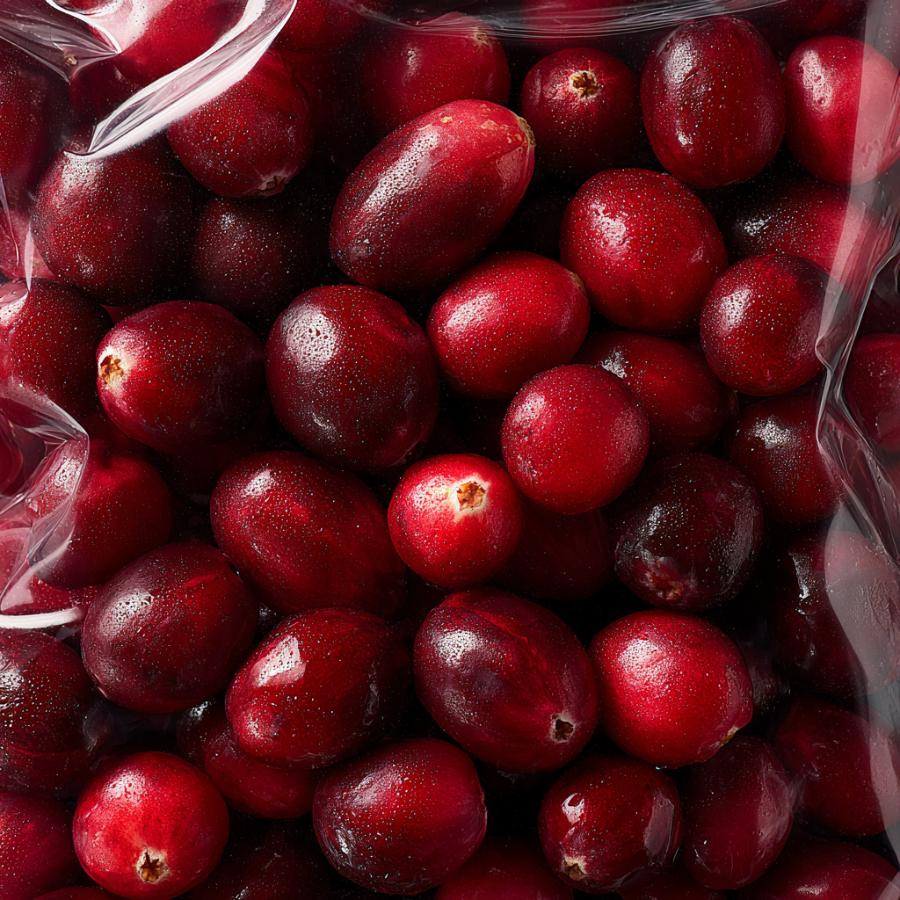
Cranberries sold in Plastic Bags
Fresh cranberries are sold in bags for cooking. These berries feel firm when squeezed because of the water pressure inside. If a berry dries out, it becomes soft and wrinkled. The water keeps the shape and texture. When people cook with fresh cranberries, the heat causes the water to expand and burst the skin. This releases the juice and creates the sauce.
Cranberries store water efficiently. The plant uses a system of tiny tubes to move water from roots to berries. This process is called transpiration. On hot days, water evaporates from the leaves to cool the plant. The roots pull in more water from the soil to replace it. This cycle keeps the berries plump. In winter, growers flood the bogs again to cover the vines with ice. The ice protects the plants from cold and wind. When spring comes, the ice melts, and the water soaks into the soil for the next growing season.
Expensive to Ship
The water in cranberries affects their weight and shipping. A truckload of fresh cranberries is mostly water by mass. This makes transportation expensive because growers pay to move water across long distances. Some companies remove water to make dried cranberries. The drying process uses heat or air to evaporate most of the water. One pound of dried cranberries comes from about five pounds of fresh berries.
Water also plays a role in cranberry nutrition. The high water content means cranberries have few calories. One cup of fresh cranberries has only 46 calories. Most of the solid part is carbohydrates, including fiber and natural sugars. The water dilutes these nutrients, so a person must eat many berries to get a large amount of any one nutrient. Still, the juice provides vitamin C and antioxidants dissolved in the water.
Scientists study the water in cranberries to improve growing methods. They measure soil moisture with sensors. They track how much water the vines use each day. This helps growers save water and reduce costs. In dry years, irrigation systems supply extra water from reservoirs. In wet years, pumps remove excess water to prevent root rot. Modern bogs use computers to open and close water gates automatically.
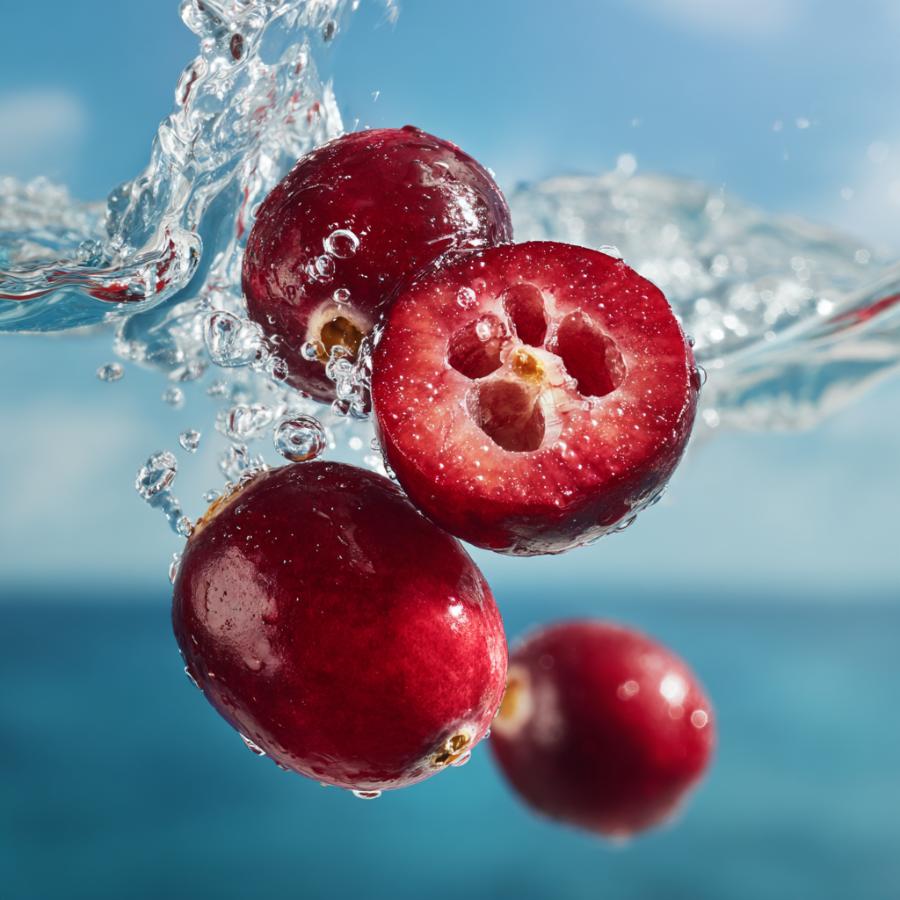
Cool Air Pockets inside a Cranberry
The air pockets inside cranberries form early in development. As the flower turns into a berry, cells divide and create empty spaces. These spaces fill with air as the berry grows. The air pockets take up about 2% of the berry’s volume. Combined with the 88% water, this leaves little room for solid material. The skin, seeds, and flesh make up the rest.
Cranberry juice concentrate is made by removing water. Processors heat the juice and evaporate the liquid until only a thick syrup remains. This concentrate is easier to ship and store. To make juice again, factories add water back. The final product tastes similar to fresh juice but may have added sugar or other flavors.
Frozen cranberries also rely on water. When berries are frozen quickly, the water inside forms tiny ice crystals. These crystals keep the berry’s shape. Slow freezing creates large crystals that break the cell walls. When thawed, the berry becomes mushy. Commercial freezers use cold air to freeze berries fast and preserve texture.
Water quality matters for cranberry growing. The water in bogs must be clean and low in salts. Polluted water can harm the plants or add unwanted chemicals to the fruit. Growers test water regularly. They avoid pesticides that could wash into streams. Many bogs are in protected wetlands, which helps keep the water pure.
In essence, the high water content shapes how cranberries are grown, picked, shipped, and eaten. Every step of cranberry production connects back to this simple but essential substance. Like I always say, cranberries are awesome!
More Cranberry Fun Facts
- 🔴 Fact # 2 – Cranberries are one of three fruits that are native to North America.
- 🔴 Fact # 3 – The 5 states that are responsible for for growing almost all of the cranberries in North America are: Massachusetts, Wisconsin, New Jersey, Oregon, and Washington.
- 🔴 Fact # 4 – Cranberries have small air pockets inside them, and that’s what makes them float during harvest.
- 🔴 Fact # 5 – Cranberries don’t grow in water, they are just (mainly) harvested that way.
- 🔴 Fact # 6 – The typical cranberry harvesting season is from September to mid-November.
Fact # 7 – Cranberries were used by native Americans as a dye. - 🔴 Fact # 7 – Cranberries are high in vitamin C.
- 🔴 Fact # 8 – Less than 10% of cranberries are sold fresh.
- 🔴 Fact # 9 – One cup to cranberries is about 50 calories.
More Cranberry Info
- 🔴 Fact # 10 Cranberries are awesome!
Click on the links within those facts to get more information on each. Or click here for all posts on fun facts about cranberries, and here for recipes with cranberries.
– Cranby
